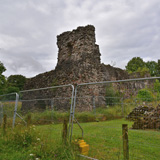History
Lochmaben Castle is located in southwest Scotland along a route much traveled through Annandale in medieval times due to forest and marshlands along the borders. The Brus family were Lords of Annandale in the 12th century and settled in Lochmaban around 1200, building a motte-style castle near the modern-day Lochmaben golf course. The Brus family were ancestors of Robert the Bruce, and Robert's grandfather, Robert Bruce “The Competitor,"" died at the motte castle in 1295.

In 1298, during the Wars of Scottish Independence, Edward I of England captured the motte castle and strengthened it. Edward then built a new "peel" or timber fort at the current site. The following year, The Earl of Carrick, future Robert the Bruce, besieged the castle for five days, but the castle held. In 1301, the Scots took the castle under John de Soules, who burned it to the ground.
In 1306, Robert the Bruce succeeded in taking Lochmaben Castle, but the Prince of Wales soon retook it. In 1333, the Scots retook the castle, which was also short-lived, as the English took it back and garrisoned it. They would hold it for the next 50 years.
By 1364, the stone castle we see today was in place, and in February of 1384, the border truce with England expired. The English were ousted from Lochmaben Castle in 1385 by the Scots and Archibald the Grim, Lord of Galloway and illegitimate son of James Douglas.
In 1410, the Maxwells were made castle custodians of the Lochmaben Castle, but it passed to the crown in 1445 when James II acquired it after he defeated the Black Douglas. In 1482, it was garrisoned with 100 men of war.
Around 1500, James IV started significant works at the castle, including rebuilding the great hall. James V would visit the castle often and used it as a mustering base before campaigns in England before he died in 1542. In 1544, English forces again captured the castle during the "Rough Wooing" in Scotland by Henry VIII. It was recaptured the following year by the Scots.
Mary Queen of Scots and Lord Darnley visited the castle in October of 1565 at the end of the Chaseabout Raid. Lochmaben Castle was garrisoned by Lord Maxwell in 1588 as part of a planned Catholic rebellion. The castle was besieged and taken back by James VI's army. David Maxell and five others were hanged.
The castle remained an important site in the wars with England before it was eventually abandoned in the 1700s, and much of the stonework was removed and reused in local buildings in Lochmaben.
Castle Highlights
Lochmaben Castle is currently closed to visitors as a safety precaution while Historic Environment Scotland undertakes masonry inspections at several sites in Scotland. It is viewable from outside the safety fencing, but no access is allowed inside the fence.
What remains today are stone ruins from the 13th century and a 15th century tower, with portions of a curtain wall and ditch where a moat once surrounded the castle.
Though an important castle packed with history, little remains of this castle to explore and even less with it being fenced off. Once it reopens, it can be explored in about an hour. It is worth a visit if you also plan to visit Caerlaverlock Castle nearby.
A vampire supposedly lurks in thw woods and grounds surrounding Lochmaben Castle.



